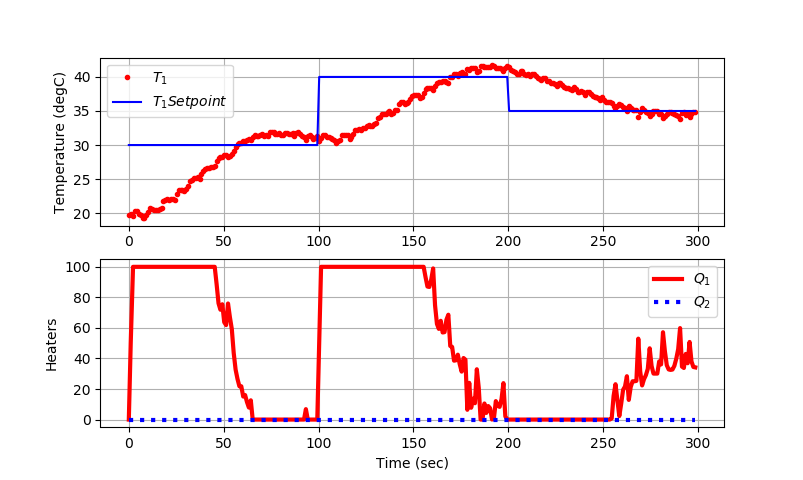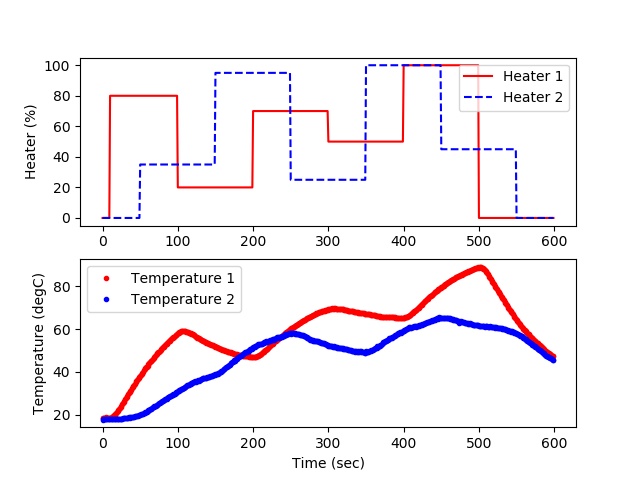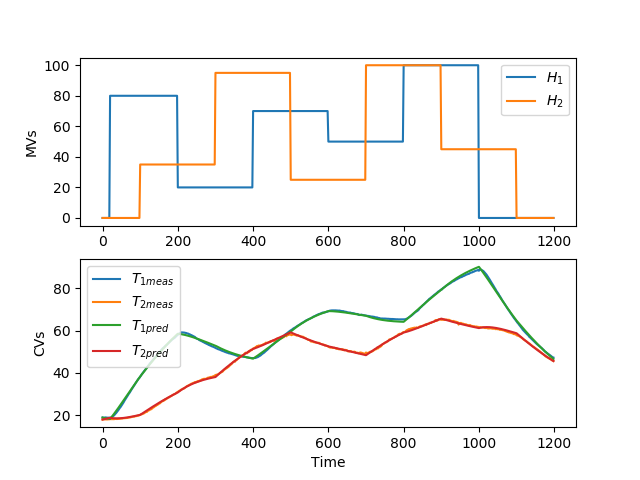The TCLab is a hands-on application of machine learning and advanced temperature control with two heaters and two temperature sensors. The labs reinforce principles of model development, estimation, and advanced control methods. This is the sixth exercise and it involves linear model predictive control with an empirical 2nd order model. The predictions were previously aligned to the measured values through an estimator. This model predictive controller uses those parameters and a linear model of the TCLab input to output response to control temperatures to a set point.
See information on Model Predictive Control (MPC) and MPC Examples in Excel, MATLAB, Simulink, and Python.
Lab Problem Statement
Data and Solutions
Python GEKKO 1st Order Model

import numpy as np
import time
import matplotlib.pyplot as plt
from gekko import GEKKO
# Connect to Arduino
a = tclab.TCLab()
# Get Version
print(a.version)
# Turn LED on
print('LED On')
a.LED(100)
# Run time in minutes
run_time = 5.0
# Number of cycles
loops = int(60.0*run_time)
tm = np.zeros(loops)
# Temperature (K)
T1 = np.ones(loops) * a.T1 # temperature (degC)
Tsp1 = np.ones(loops) * 30.0 # set point (degC)
# Set point changes
Tsp1[100:] = 40.0
Tsp1[200:] = 35.0
T2 = np.ones(loops) * a.T2 # temperature (degC)
Tsp2 = np.ones(loops) * 23.0 # set point (degC)
# heater values
Q1s = np.ones(loops) * 0.0
Q2s = np.ones(loops) * 0.0
#########################################################
# Initialize Model
#########################################################
m = GEKKO(name='tclab-mpc',remote=False)
# 30 second time horizon
m.time = np.linspace(0,30,31)
# Parameters
Q1_ss = m.Param(value=0)
TC1_ss = m.Param(value=23)
Kp = m.Param(value=0.4)
tau = m.Param(value=160.0)
# Manipulated variable
Q1 = m.MV(value=0)
Q1.STATUS = 1 # use to control temperature
Q1.FSTATUS = 0 # no feedback measurement
Q1.LOWER = 0.0
Q1.UPPER = 100.0
Q1.DMAX = 50.0
Q1.COST = 0.0
Q1.DCOST = 1.0e-4
# Controlled variable
TC1 = m.CV(value=TC1_ss.value)
TC1.STATUS = 1 # minimize error with setpoint range
TC1.FSTATUS = 1 # receive measurement
TC1.TR_INIT = 2 # reference trajectory
TC1.TAU = 10 # time constant for response
# Equation
m.Equation(tau * TC1.dt() + (TC1-TC1_ss) == Kp * (Q1-Q1_ss))
# Global Options
m.options.IMODE = 6 # MPC
m.options.CV_TYPE = 1 # Objective type
m.options.NODES = 3 # Collocation nodes
m.options.SOLVER = 1 # 1=APOPT, 3=IPOPT
##################################################################
# Create plot
plt.figure()
plt.ion()
plt.show()
# Main Loop
start_time = time.time()
prev_time = start_time
try:
for i in range(1,loops):
# Sleep time
sleep_max = 1.0
sleep = sleep_max - (time.time() - prev_time)
if sleep>=0.01:
time.sleep(sleep)
else:
time.sleep(0.01)
# Record time and change in time
t = time.time()
dt = t - prev_time
prev_time = t
tm[i] = t - start_time
# Read temperatures in Kelvin
T1[i] = a.T1
T2[i] = a.T2
###############################
### MPC CONTROLLER ###
###############################
TC1.MEAS = T1[i]
# input setpoint with deadband +/- DT
DT = 0.1
TC1.SPHI = Tsp1[i] + DT
TC1.SPLO = Tsp1[i] - DT
# solve MPC
m.solve(disp=False)
# test for successful solution
if (m.options.APPSTATUS==1):
# retrieve the first Q value
Q1s[i] = Q1.NEWVAL
else:
# not successful, set heater to zero
Q1s[i] = 0
# Write output (0-100)
a.Q1(Q1s[i])
a.Q2(Q2s[i])
# Plot
plt.clf()
ax=plt.subplot(2,1,1)
ax.grid()
plt.plot(tm[0:i],T1[0:i],'ro',MarkerSize=3,label=r'$T_1$')
plt.plot(tm[0:i],Tsp1[0:i],'b-',MarkerSize=3,label=r'$T_1 Setpoint$')
plt.ylabel('Temperature (degC)')
plt.legend(loc='best')
ax=plt.subplot(2,1,2)
ax.grid()
plt.plot(tm[0:i],Q1s[0:i],'r-',lw=3,label=r'$Q_1$')
plt.plot(tm[0:i],Q2s[0:i],'b:',lw=3,label=r'$Q_2$')
plt.ylabel('Heaters')
plt.xlabel('Time (sec)')
plt.legend(loc='best')
plt.draw()
plt.pause(0.05)
# Turn off heaters
a.Q1(0)
a.Q2(0)
print('Shutting down')
# Allow user to end loop with Ctrl-C
except KeyboardInterrupt:
# Disconnect from Arduino
a.Q1(0)
a.Q2(0)
print('Shutting down')
a.close()
# Make sure serial connection still closes when there's an error
except:
# Disconnect from Arduino
a.Q1(0)
a.Q2(0)
print('Error: Shutting down')
a.close()
raise
Python GEKKO 2nd Order Model
Note: Switch to make_mp4 = True to make an MP4 movie animation. This requires imageio and ffmpeg (install available through Python). It creates a folder named figures in your run directory. You can delete this folder after the run is complete.
import time
import matplotlib.pyplot as plt
import random
import json
# get gekko package with:
# pip install gekko
from gekko import GEKKO
# get tclab package with:
# pip install tclab
from tclab import TCLab
# Connect to Arduino
a = TCLab()
# Make an MP4 animation?
make_mp4 = False
if make_mp4:
import imageio # required to make animation
import os
try:
os.mkdir('./figures')
except:
pass
# Final time
tf = 10 # min
# number of data points (every 3 seconds)
n = tf * 20 + 1
# Percent Heater (0-100%)
Q1s = np.zeros(n)
Q2s = np.zeros(n)
# Temperatures (degC)
T1m = a.T1 * np.ones(n)
T2m = a.T2 * np.ones(n)
# Temperature setpoints
T1sp = T1m[0] * np.ones(n)
T2sp = T2m[0] * np.ones(n)
# Heater set point steps about every 150 sec
T1sp[3:] = 40.0
T2sp[40:] = 30.0
T1sp[80:] = 32.0
T2sp[120:] = 35.0
T1sp[160:] = 45.0
#########################################################
# Initialize Model
#########################################################
m = GEKKO(name='tclab-mpc',remote=False)
# with a local server
#m = GEKKO(name='tclab-mpc',server='http://127.0.0.1',remote=True)
# Control horizon, non-uniform time steps
m.time = [0,3,6,10,14,18,22,27,32,38,45,55,65, \
75,90,110,130,150]
# Parameters from Estimation
K1 = m.FV(value=0.607)
K2 = m.FV(value=0.293)
K3 = m.FV(value=0.24)
tau12 = m.FV(value=192)
tau3 = m.FV(value=15)
# don't update parameters with optimizer
K1.STATUS = 0
K2.STATUS = 0
K3.STATUS = 0
tau12.STATUS = 0
tau3.STATUS = 0
# Manipulated variables
Q1 = m.MV(value=0,name='q1')
Q1.STATUS = 1 # manipulated
Q1.FSTATUS = 0 # not measured
Q1.DMAX = 20.0
Q1.DCOST = 0.1
Q1.UPPER = 100.0
Q1.LOWER = 0.0
Q2 = m.MV(value=0,name='q2')
Q2.STATUS = 1 # manipulated
Q2.FSTATUS = 0 # not measured
Q2.DMAX = 30.0
Q2.DCOST = 0.1
Q2.UPPER = 100.0
Q2.LOWER = 0.0
# State variables
TH1 = m.SV(value=T1m[0])
TH2 = m.SV(value=T2m[0])
# Controlled variables
TC1 = m.CV(value=T1m[0],name='tc1')
TC1.STATUS = 1 # drive to set point
TC1.FSTATUS = 1 # receive measurement
TC1.TAU = 40 # response speed (time constant)
TC1.TR_INIT = 1 # reference trajectory
TC1.TR_OPEN = 0
TC2 = m.CV(value=T2m[0],name='tc2')
TC2.STATUS = 1 # drive to set point
TC2.FSTATUS = 1 # receive measurement
TC2.TAU = 0 # response speed (time constant)
TC2.TR_INIT = 0 # dead-band
TC2.TR_OPEN = 1
Ta = m.Param(value=23.0) # degC
# Heat transfer between two heaters
DT = m.Intermediate(TH2-TH1)
# Empirical correlations
m.Equation(tau12 * TH1.dt() + (TH1-Ta) == K1*Q1 + K3*DT)
m.Equation(tau12 * TH2.dt() + (TH2-Ta) == K2*Q2 - K3*DT)
m.Equation(tau3 * TC1.dt() + TC1 == TH1)
m.Equation(tau3 * TC2.dt() + TC2 == TH2)
# Global Options
m.options.IMODE = 6 # MPC
m.options.CV_TYPE = 1 # Objective type
m.options.NODES = 3 # Collocation nodes
m.options.SOLVER = 3 # IPOPT
m.options.COLDSTART = 1 # COLDSTART on first cycle
##################################################################
# Create plot
plt.figure(figsize=(10,7))
plt.ion()
plt.show()
# Main Loop
start_time = time.time()
prev_time = start_time
tm = np.zeros(n)
try:
for i in range(1,n-1):
# Sleep time
sleep_max = 3.0
sleep = sleep_max - (time.time() - prev_time)
if sleep>=0.01:
time.sleep(sleep-0.01)
else:
time.sleep(0.01)
# Record time and change in time
t = time.time()
dt = t - prev_time
prev_time = t
tm[i] = t - start_time
# Read temperatures in Celsius
T1m[i] = a.T1
T2m[i] = a.T2
# Insert measurements
TC1.MEAS = T1m[i]
TC2.MEAS = T2m[i]
# Adjust setpoints
db1 = 1.0 # dead-band
TC1.SPHI = T1sp[i] + db1
TC1.SPLO = T1sp[i] - db1
db2 = 0.2
TC2.SPHI = T2sp[i] + db2
TC2.SPLO = T2sp[i] - db2
# Adjust heaters with MPC
m.solve()
if m.options.APPSTATUS == 1:
# Retrieve new values
Q1s[i+1] = Q1.NEWVAL
Q2s[i+1] = Q2.NEWVAL
# get additional solution information
with open(m.path+'//results.json') as f:
results = json.load(f)
else:
# Solution failed
Q1s[i+1] = 0.0
Q2s[i+1] = 0.0
# Write new heater values (0-100)
a.Q1(Q1s[i])
a.Q2(Q2s[i])
# Plot
plt.clf()
ax=plt.subplot(3,1,1)
ax.grid()
plt.plot(tm[0:i+1],T1sp[0:i+1]+db1,'k-',\
label=r'$T_1$ target',lw=3)
plt.plot(tm[0:i+1],T1sp[0:i+1]-db1,'k-',\
label=None,lw=3)
plt.plot(tm[0:i+1],T1m[0:i+1],'r.',label=r'$T_1$ measured')
plt.plot(tm[i]+m.time,results['tc1.bcv'],'r-',\
label=r'$T_1$ predicted',lw=3)
plt.plot(tm[i]+m.time,results['tc1.tr_hi'],'k--',\
label=r'$T_1$ trajectory')
plt.plot(tm[i]+m.time,results['tc1.tr_lo'],'k--')
plt.ylabel('Temperature (degC)')
plt.legend(loc=2)
ax=plt.subplot(3,1,2)
ax.grid()
plt.plot(tm[0:i+1],T2sp[0:i+1]+db2,'k-',\
label=r'$T_2$ target',lw=3)
plt.plot(tm[0:i+1],T2sp[0:i+1]-db2,'k-',\
label=None,lw=3)
plt.plot(tm[0:i+1],T2m[0:i+1],'b.',label=r'$T_2$ measured')
plt.plot(tm[i]+m.time,results['tc2.bcv'],'b-',\
label=r'$T_2$ predict',lw=3)
plt.plot(tm[i]+m.time,results['tc2.tr_hi'],'k--',\
label=r'$T_2$ range')
plt.plot(tm[i]+m.time,results['tc2.tr_lo'],'k--')
plt.ylabel('Temperature (degC)')
plt.legend(loc=2)
ax=plt.subplot(3,1,3)
ax.grid()
plt.plot([tm[i],tm[i]],[0,100],'k-',\
label='Current Time',lw=1)
plt.plot(tm[0:i+1],Q1s[0:i+1],'r.-',\
label=r'$Q_1$ history',lw=2)
plt.plot(tm[i]+m.time,Q1.value,'r-',\
label=r'$Q_1$ plan',lw=3)
plt.plot(tm[0:i+1],Q2s[0:i+1],'b.-',\
label=r'$Q_2$ history',lw=2)
plt.plot(tm[i]+m.time,Q2.value,'b-',
label=r'$Q_2$ plan',lw=3)
plt.plot(tm[i]+m.time[1],Q1.value[1],color='red',\
marker='.',markersize=15)
plt.plot(tm[i]+m.time[1],Q2.value[1],color='blue',\
marker='X',markersize=8)
plt.ylabel('Heaters')
plt.xlabel('Time (sec)')
plt.legend(loc=2)
plt.draw()
plt.pause(0.05)
if make_mp4:
filename='./figures/plot_'+str(i+10000)+'.png'
plt.savefig(filename)
# Turn off heaters and close connection
a.Q1(0)
a.Q2(0)
a.close()
# Save figure
plt.savefig('tclab_mpc.png')
# generate mp4 from png figures in batches of 350
if make_mp4:
images = []
iset = 0
for i in range(1,n-1):
filename='./figures/plot_'+str(i+10000)+'.png'
images.append(imageio.imread(filename))
if ((i+1)%350)==0:
imageio.mimsave('results_'+str(iset)+'.mp4', images)
iset += 1
images = []
if images!=[]:
imageio.mimsave('results_'+str(iset)+'.mp4', images)
# Allow user to end loop with Ctrl-C
except KeyboardInterrupt:
# Turn off heaters and close connection
a.Q1(0)
a.Q2(0)
a.close()
print('Shutting down')
plt.savefig('tclab_mpc.png')
# Make sure serial connection still closes when there's an error
except:
# Disconnect from Arduino
a.Q1(0)
a.Q2(0)
a.close()
print('Error: Shutting down')
plt.savefig('tclab_mpc.png')
raise
Python GEKKO System ID with ARX Model
See SISO Model Identification for information on creating a single heater, single temperature control model.
See MIMO Model Identification for additional help on creating and step testing a MIMO (Multiple Input, Multiple Output) Auto-regressive exogenous (ARX) input model.

import pandas as pd
import tclab
import time
import matplotlib.pyplot as plt
# generate step test data on Arduino
filename = 'tclab_2sec.csv'
# heater steps
Q1d = np.zeros(601)
Q1d[10:100] = 80
Q1d[100:200] = 20
Q1d[200:300] = 70
Q1d[300:400] = 50
Q1d[400:500] = 100
Q1d[500:] = 0
Q2d = np.zeros(601)
Q2d[50:150] = 35
Q2d[150:250] = 95
Q2d[250:350] = 25
Q2d[350:450] = 100
Q2d[450:550] = 45
Q2d[550:] = 0
# Connect to Arduino
a = tclab.TCLab()
fid = open(filename,'w')
fid.write('Time,H1,H2,T1,T2\n')
fid.close()
# run step test (20 min)
for i in range(601):
# set heater values
a.Q1(Q1d[i])
a.Q2(Q2d[i])
print('Time: ' + str(2*i) + \
' H1: ' + str(Q1d[i]) + \
' H2: ' + str(Q2d[i]) + \
' T1: ' + str(a.T1) + \
' T2: ' + str(a.T2))
# wait 2 seconds
time.sleep(2)
fid = open(filename,'a')
fid.write(str(2*i)+','+str(Q1d[i])+','+str(Q2d[i])+',' \
+str(a.T1)+','+str(a.T2)+'\n')
fid.close()
# close connection to Arduino
a.close()
# read data file
data = pd.read_csv(filename)
# plot measurements
plt.figure()
plt.subplot(2,1,1)
plt.plot(data['Time'],data['H1'],'r-',label='Heater 1')
plt.plot(data['Time'],data['H2'],'b--',label='Heater 2')
plt.ylabel('Heater (%)')
plt.legend(loc='best')
plt.subplot(2,1,2)
plt.plot(data['Time'],data['T1'],'r.',label='Temperature 1')
plt.plot(data['Time'],data['T2'],'b.',label='Temperature 2')
plt.ylabel('Temperature (degC)')
plt.legend(loc='best')
plt.xlabel('Time (sec)')
plt.savefig('tclab_dyn_2sec.png')
plt.show()
TCLab Step Test Data for ARX Fit (20 min with `\Delta t` = 2 sec)

Note: Switch to make_mp4 = True to make an MP4 movie animation. This requires imageio and ffmpeg (install available through Python). It creates a folder named figures in your run directory. You can delete this folder after the run is complete.
import time
import matplotlib.pyplot as plt
import pandas as pd
import json
# get gekko package with:
# pip install gekko
from gekko import GEKKO
# get tclab package with:
# pip install tclab
from tclab import TCLab
# Connect to Arduino
a = TCLab()
# Make an MP4 animation?
make_mp4 = False
if make_mp4:
import imageio # required to make animation
import os
try:
os.mkdir('./figures')
except:
pass
# Final time
tf = 10 # min
# number of data points (every 2 seconds)
n = tf * 30 + 1
# Percent Heater (0-100%)
Q1s = np.zeros(n)
Q2s = np.zeros(n)
# Temperatures (degC)
T1m = a.T1 * np.ones(n)
T2m = a.T2 * np.ones(n)
# Temperature setpoints
T1sp = T1m[0] * np.ones(n)
T2sp = T2m[0] * np.ones(n)
# Heater set point steps about every 150 sec
T1sp[3:] = 50.0
T2sp[40:] = 35.0
T1sp[80:] = 30.0
T2sp[120:] = 50.0
T1sp[160:] = 45.0
T2sp[200:] = 35.0
T1sp[240:] = 60.0
#########################################################
# Initialize Model
#########################################################
# load data (20 min, dt=2 sec) and parse into columns
url = 'http://apmonitor.com/do/uploads/Main/tclab_2sec.txt'
data = pd.read_csv(url)
t = data['Time']
u = data[['H1','H2']]
y = data[['T1','T2']]
# generate time-series model
m = GEKKO()
##################################################################
# system identification
na = 2 # output coefficients
nb = 2 # input coefficients
print('Identify model')
yp,p,K = m.sysid(t,u,y,na,nb,objf=10000,scale=False,diaglevel=1)
##################################################################
# plot sysid results
plt.figure()
plt.subplot(2,1,1)
plt.plot(t,u)
plt.legend([r'$H_1$',r'$H_2$'])
plt.ylabel('MVs')
plt.subplot(2,1,2)
plt.plot(t,y)
plt.plot(t,yp)
plt.legend([r'$T_{1meas}$',r'$T_{2meas}$',\
r'$T_{1pred}$',r'$T_{2pred}$'])
plt.ylabel('CVs')
plt.xlabel('Time')
plt.savefig('sysid.png')
plt.show()
##################################################################
# create control ARX model
y = m.Array(m.CV,2)
u = m.Array(m.MV,2)
m.arx(p,y,u)
# rename CVs
TC1 = y[0]
TC2 = y[1]
# rename MVs
Q1 = u[0]
Q2 = u[1]
# steady state initialization
m.options.IMODE = 1
m.solve(disp=False)
# set up MPC
m.options.IMODE = 6 # MPC
m.options.CV_TYPE = 1 # Objective type
m.options.NODES = 2 # Collocation nodes
m.options.SOLVER = 3 # IPOPT
m.time=np.linspace(0,120,61)
# Manipulated variables
Q1.STATUS = 1 # manipulated
Q1.FSTATUS = 0 # not measured
Q1.DMAX = 50.0
Q1.DCOST = 0.1
Q1.UPPER = 100.0
Q1.LOWER = 0.0
Q2.STATUS = 1 # manipulated
Q2.FSTATUS = 0 # not measured
Q2.DMAX = 50.0
Q2.DCOST = 0.1
Q2.UPPER = 100.0
Q2.LOWER = 0.0
# Controlled variables
TC1.STATUS = 1 # drive to set point
TC1.FSTATUS = 1 # receive measurement
TC1.TAU = 20 # response speed (time constant)
TC1.TR_INIT = 2 # reference trajectory
TC1.TR_OPEN = 0
TC2.STATUS = 1 # drive to set point
TC2.FSTATUS = 1 # receive measurement
TC2.TAU = 20 # response speed (time constant)
TC2.TR_INIT = 2 # dead-band
TC2.TR_OPEN = 1
##################################################################
# Create plot
plt.figure(figsize=(10,7))
plt.ion()
plt.show()
# Main Loop
start_time = time.time()
prev_time = start_time
tm = np.zeros(n)
try:
for i in range(1,n-1):
# Sleep time
sleep_max = 2.0
sleep = sleep_max - (time.time() - prev_time)
if sleep>=0.01:
time.sleep(sleep-0.01)
else:
time.sleep(0.01)
# Record time and change in time
t = time.time()
dt = t - prev_time
prev_time = t
tm[i] = t - start_time
# Read temperatures in Celsius
T1m[i] = a.T1
T2m[i] = a.T2
# Insert measurements
TC1.MEAS = T1m[i]
TC2.MEAS = T2m[i]
# Adjust setpoints
db1 = 1.0 # dead-band
TC1.SPHI = T1sp[i] + db1
TC1.SPLO = T1sp[i] - db1
db2 = 0.2
TC2.SPHI = T2sp[i] + db2
TC2.SPLO = T2sp[i] - db2
# Adjust heaters with MPC
m.solve()
if m.options.APPSTATUS == 1:
# Retrieve new values
Q1s[i+1] = Q1.NEWVAL
Q2s[i+1] = Q2.NEWVAL
# get additional solution information
with open(m.path+'//results.json') as f:
results = json.load(f)
else:
# Solution failed
Q1s[i+1] = 0.0
Q2s[i+1] = 0.0
# Write new heater values (0-100)
a.Q1(Q1s[i])
a.Q2(Q2s[i])
# Plot
plt.clf()
ax=plt.subplot(3,1,1)
ax.grid()
plt.plot(tm[0:i+1],T1sp[0:i+1]+db1,'k-',\
label=r'$T_1$ target',lw=3)
plt.plot(tm[0:i+1],T1sp[0:i+1]-db1,'k-',\
label=None,lw=3)
plt.plot(tm[0:i+1],T1m[0:i+1],'r.',label=r'$T_1$ measured')
plt.plot(tm[i]+m.time,results['v1.bcv'],'r-',\
label=r'$T_1$ predicted',lw=3)
plt.plot(tm[i]+m.time,results['v1.tr_hi'],'k--',\
label=r'$T_1$ trajectory')
plt.plot(tm[i]+m.time,results['v1.tr_lo'],'k--')
plt.ylabel('Temperature (degC)')
plt.legend(loc=2)
ax=plt.subplot(3,1,2)
ax.grid()
plt.plot(tm[0:i+1],T2sp[0:i+1]+db2,'k-',\
label=r'$T_2$ target',lw=3)
plt.plot(tm[0:i+1],T2sp[0:i+1]-db2,'k-',\
label=None,lw=3)
plt.plot(tm[0:i+1],T2m[0:i+1],'b.',label=r'$T_2$ measured')
plt.plot(tm[i]+m.time,results['v2.bcv'],'b-',\
label=r'$T_2$ predict',lw=3)
plt.plot(tm[i]+m.time,results['v2.tr_hi'],'k--',\
label=r'$T_2$ range')
plt.plot(tm[i]+m.time,results['v2.tr_lo'],'k--')
plt.ylabel('Temperature (degC)')
plt.legend(loc=2)
ax=plt.subplot(3,1,3)
ax.grid()
plt.plot([tm[i],tm[i]],[0,100],'k-',\
label='Current Time',lw=1)
plt.plot(tm[0:i+1],Q1s[0:i+1],'r.-',\
label=r'$Q_1$ history',lw=2)
plt.plot(tm[i]+m.time,Q1.value,'r-',\
label=r'$Q_1$ plan',lw=3)
plt.plot(tm[0:i+1],Q2s[0:i+1],'b.-',\
label=r'$Q_2$ history',lw=2)
plt.plot(tm[i]+m.time,Q2.value,'b-',
label=r'$Q_2$ plan',lw=3)
plt.plot(tm[i]+m.time[1],Q1.value[1],color='red',\
marker='.',markersize=15)
plt.plot(tm[i]+m.time[1],Q2.value[1],color='blue',\
marker='X',markersize=8)
plt.ylabel('Heaters')
plt.xlabel('Time (sec)')
plt.legend(loc=2)
plt.draw()
plt.pause(0.05)
if make_mp4:
filename='./figures/plot_'+str(i+10000)+'.png'
plt.savefig(filename)
# Turn off heaters and close connection
a.Q1(0)
a.Q2(0)
a.close()
# Save figure
plt.savefig('tclab_mpc.png')
# generate mp4 from png figures in batches of 350
if make_mp4:
images = []
iset = 0
for i in range(1,n-1):
filename='./figures/plot_'+str(i+10000)+'.png'
images.append(imageio.imread(filename))
if ((i+1)%350)==0:
imageio.mimsave('results_'+str(iset)+'.mp4', images)
iset += 1
images = []
if images!=[]:
imageio.mimsave('results_'+str(iset)+'.mp4', images)
# Allow user to end loop with Ctrl-C
except KeyboardInterrupt:
# Turn off heaters and close connection
a.Q1(0)
a.Q2(0)
a.close()
print('Shutting down')
plt.savefig('tclab_mpc.png')
# Make sure serial connection still closes when there's an error
except:
# Disconnect from Arduino
a.Q1(0)
a.Q2(0)
a.close()
print('Error: Shutting down')
plt.savefig('tclab_mpc.png')
raise
See also:
